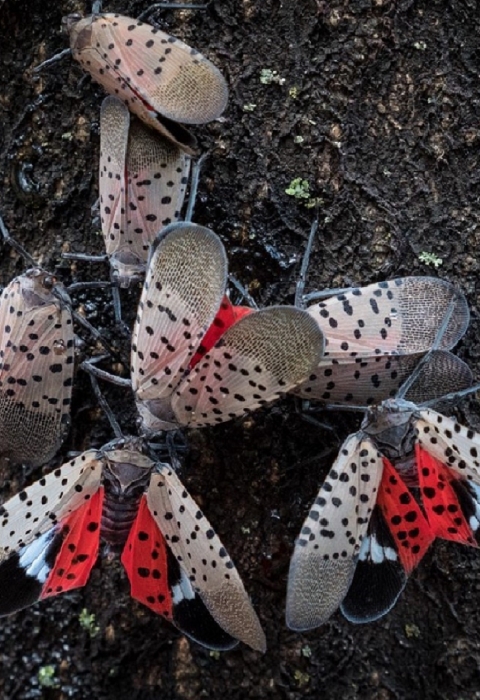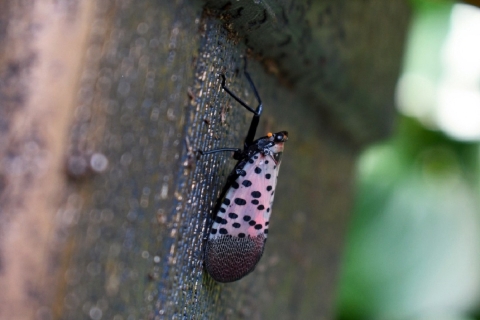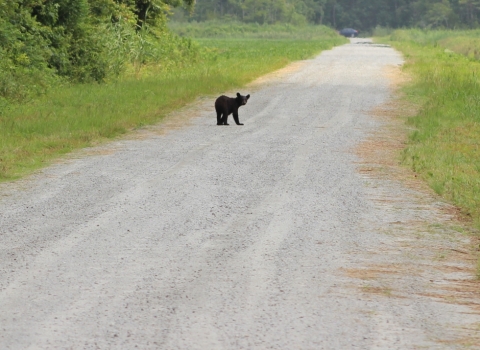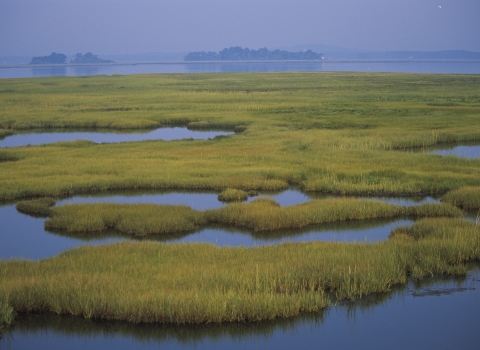With polka-dotted forewings, and bold red underwings, the spotted lanternfly is an alluring insect. Looks can be deceiving.
First detected in Berks County, Pennsylvania, in 2014, the spotted lanternfly has now spread to 15 states, leaving destruction in its wake. Its population is particularly large across New York, New Jersey, and Philadelphia.
But, the invasive insect is more than an annoying bug on your windshield. It poses a major threat to the ecosystem health and to important regional agricultural economies, especially apple orchards and vineyards.
Disaster lurks
Native to southern China, Vietnam, and Taiwan, the spotted lanternfly began to spread in the early 2000s, first to South Korea and Japan, and then to the United States. Like many other invasive species invasive species
An invasive species is any plant or animal that has spread or been introduced into a new area where they are, or could, cause harm to the environment, economy, or human, animal, or plant health. Their unwelcome presence can destroy ecosystems and cost millions of dollars.
Learn more about invasive species , it was introduced to new turf accidentally through imported goods.
Spotted lanternfly is now present in Connecticut, Delaware, Indiana, Maryland, Massachusetts, Michigan, New Jersey, New York, North Carolina, Ohio, Pennsylvania, Rhode Island, Virginia, and West Virginia. Its threat continues to reach further west and grow more intensely in existing areas.
“Spotted lanternfly has spread so much faster than a lot of invasives that we’ve seen in the past,” said Matthew Gallo of the Finger Lakes chapter of the Partnership for Regional Invasive Species Management (PRISM). “Gypsy moths took almost 100 years just to spread from Massachusetts to New York. Spotted lanternfly has made it to 10 states in only seven years.”
Get to know the spotted lanternfly
Spotted lanternfly are planthoppers, categorized as such due to their ability to hop from surface to surface and hold on tight when they land. The insects pass through four distinct life stages (called first, second, third, and fourth instars) in a matter of months before maturing into adults with their eye-catching red underwings. Adults lay eggs in the fall that hatch the following spring, beginning the life cycle over again.
As soon as they hatch, they begin to feed on woody plant species, with a notable preference for the Ailanthus tree, commonly known as “tree of heaven.”
Tree of heaven is itself an invasive species. It is prevalent throughout most of the Northeast and is not easy to eradicate. Cutting a tree of heaven down only spurs new growth through its aggressive root system. But, regardless, removing tree of heaven won’t remove spotted lanternfly—there’s plenty more for it to eat. The insect has been documented feeding on more than 70 different species, including maple trees, oak trees, grape vines, and apple trees.
Appetite for destruction
Spotted lanternfly feed using piercing mouthparts to access sap beneath a tree’s bark. That alone can cause harm a tree, but it gets worse. After feeding, spotted lanternfly excrete a substance called honeydew: partially digested sap that attracts other nuisance insects to the host tree and causes the growth of a fungus called sooty mold.
The fungus stresses the tree, leaving it vulnerable to other diseases and pests, and disrupts photosynthesis, stunting the growth and overall health of the tree. In cases where the host plant provides an economically important commodity, like apple trees or grape vines, the mold also affects the look, taste, and smell of the fruit.
Beyond the potential destruction that these pests could bring to the region’s apple and wine industries, spotted lanternfly poses an ecological threat too.
The insect causes harm to native trees and forests, potentially destroying habitat for countless species. Bats that roost in trees for part of the year may find less available habitat. The same goes for birds, mammals, and reptiles that rely on woody vegetation for habitat and food.
Lights out for the lanternfly
The best way to fend off an aggressive invasive insect like the spotted lanternfly is to curb the spread. That requires collaboration among federal, state, and non-profit organizations, as well as residents of states vulnerable to infestations.
Education on identifying the species is an important part of hindering its continued spread. For example, along the Pennsylvania border in New York, interns with Broome County Parks have been able to provide outreach to park patrons and manage for spotted lanternfly and tree of heaven, aided by funding from the Service’s New York Field Office.
Invasive species are able to invade quickly and successfully because they have no naturalized predators. Humans are typically the reason invasives spread to new locations. In the case of spotted lanternfly, we are literally driving the problem by unknowingly transporting the insects and egg masses across state borders on our vehicles. As the ones who, inadvertently, brought the bugs to these new horizons, we have a responsibility to prevent bringing them to new ones, to protect our ecosystem from even further
Here are ways you can help keep this pest at bay:
- Learn the life stages of the spotted lanternfly and be able to identify their eggs, immatures, and adults. You should learn how to identify the tree of heaven as well. Biologists are capitalizing on the spotted lanternfly’s preference for this species by cataloging tree of heaven locations to find the pest before it spreads.
- Check your belongings before traveling. It is good to get in the habit of checking your vehicle, recreational gear, or other outdoor equipment that you plan to travel with and remove and destroy any egg masses you find on these surfaces—destroy the eggs by putting them in a plastic bag with hand sanitizer. The fall is the most important time to check your vehicles since this is when adult spotted lanternfly are laying their eggs.
- Familiarize yourself with reporting tools in your state. The USDA Animal and Plant Health Inspection Service provides a one-stop shop for state-specific reporting resources. If you notice suspicious damage to trees or are unsure if you’ve seen the insect or an egg mass, take photos and send them to your state’s specific invasive species program. Make sure to include the location where the photo was taken.
- This insect has potential to spread far and wide to many states. So as you sip your glass of wine, enjoy orchard-fresh apples, or just appreciate that beautiful fall foliage and all the wildlife habitat it represents — consider what is at stake.







